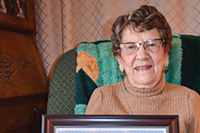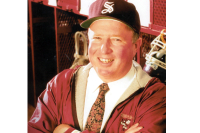When it all clicks — the art of the angle
 John MacLean will never forget his first photo shoot.
John MacLean will never forget his first photo shoot.
“I was 19 years old and it was at a meat packing plant in New Jersey,” he said.
Standing in the basement of the Cullowhee Methodist Church at Western Carolina University last Saturday, MacLean told two-dozen folks of the Sylva Photo Club about how he got into the business.
“They paid me $150 to take photos and the check bounced,” he laughed.
But MacLean wasn’t deterred. He knew photography was his passion, where he’d already had an epiphany that this was the career and life path he wanted to go down.
“I took a photography class in high school and I still have this contact sheet where this other student wrote, ‘These are cool pictures,’” he said. “When I read that, it solidified everything — people liked my images.”
Related Items
The eyes behind the lens
Growing up in suburban New Jersey, MacLean had a dark room in his basement. With his father having a deep love for photography, the youngster learned early on how to take, develop and appreciate the art of an image.
“It was about seeing that image come to life in the tray,” he said. “It was magic.”
MacLean would accompany his father to local bicycle and car races. They’d snap photos of everyday life in America, then bring the scene to life. It was a process that captivated the teenager. Following high school graduation, he found work at a handful of camera stores and learned the industry from the ground up.
“It was about self-experimentation,” he said. “There was no doubt in my mind that this is what I wanted to do, it was just a matter of experimenting with different subject matter to find what best interested me — it’s not so much about what makes you money, it was more about what makes you motivated.”
In 1982, he headed for sunny California to become a photo assistant on professional shoots around Los Angeles.
“I experienced everything from a burrito factory to a Playboy shoot, so it was pretty varied,” he smiled. “The real nuts and bolts of my knowledge and techniques came from watching how other photographers worked. It was real world experience I couldn’t get in the classroom.”
MacLean’s breakthrough in the industry came from a chance interview with acclaimed New York photographer Eric Meola, who hired him as an assistant on some high-end shoots around California.
“It was product and car photography, where I learned a lot about high-end work,” MacLean said.
And yet, after all of those shoots, MacLean was hitting a glass ceiling, eager to make his own mark. Relocating to Santa Fe, New Mexico, in 1993, he switched his title from “assistant” to “photographer,” a move that set the course for the rest of his career.
“When I moved to Santa Fe, I didn’t want to approach it as an assistant, it was time to don the photographer’s hat — fake it till you make it,” he reminisced. “I ended up befriending this general manager of a hotel in Santa Fe who then called me to shoot all of these hotels in the city.”
After a decade in New Mexico, MacLean headed back to Los Angeles for bigger projects to work on and larger clients to work with. The work was plentiful, the experiences bountiful. A few years back, MacLean packed up and headed for Western North Carolina to care for his aging parents in Franklin. And though he is far from the bright lights of California, he truly has immersed himself in the natural beauty and creative inspiration of Southern Appalachia.
“I love the scenery here,” he said. “I adore the Blue Ridge Parkway. Anytime it’s open, I’m up there, taking photos and taking it all in.”
The image of modernity
Following his presentation to the Sylva Photo Club, MacLean takes a seat in a cafeteria across the hallway. Now 52, he wonders about the future of photography, as an art form and as a career. With endless digital technology and equipment at your fingertips, the lines have become blurred between professional photographer and amateur shooter.
“In today’s world, it’s not anything like it was in the 1980s and 90s,” he said. “The problem is that there are so many people out there with a camera that think they can do it, and the thing is, they can do it, but they can’t do it to the level of production and repeatability with professional results.”
When asked if would he have become a photographer had he grown up in the 21st century, MacLean pauses for a moment, glancing out the window and back to the question posed.
“No,” he said. “It’s not something that I’d recommend for anyone to get into right now, to approach it as a business. To quit your day job and become a photographer can be a bit of a stretch. It’s better to keep it a passionate hobby these days.”
But, regardless of the place of photography in a modern world, what does remain is the singular power an image still can have on a person, where you are immediately stopped in your tracks, honed into a picture like two magnets snapping together.
“We have become a Facebook society where we scroll the wall and just look at the highlights,” he said. “If you can get people to look at a print on a wall and get some sort of emotional response from it, some connection, then it had a lot more meaning than if you just were scrolling through an album online.”
A photographer for the majority of his life, MacLean himself remains in awe of the world around him, where he constantly sees the essence of his surroundings, even in the most mundane of spaces. Beauty is in the eye of the beholder, as it is from the eyes behind the lens.
“One of the things I enjoy about photography is the vision,” he said. “You look at things differently, you see things other might take for granted when you walk by something. It’s the way a reflection hits a wall, the way a shadow is cast on the ground, any of those nondescript things people won’t pay attention to.”
When the Sylva Photo Club asked MacLean to present his work, the photographer started rummaging through an array of old images from his youth. Though the dates on the photos were decades ago, MacLean found himself transported right back to the exact moment they were taken. It is that mesmerizing ability of photography that provokes him further down the rabbit hole of his passion, further into a society he wants to expose the craft to.
“You look at those old photos and wonder where all the time went and what transpired within that big gap between then and now,” he said. “From the moment I got in photography, I felt I had something to offer the world. And, I’ve been at it so long, I’d like to give back and share the knowledge and passion with others.”
Want to know more?
For more information about John MacLean, his portfolio and about speaking engagements or workshops, click on www.johnmaclean.com.
The next meeting of the Sylva Photo Club will be with guest presenter/photographer Les Saucier at 2 p.m. March 14 at the Cullowhee Methodist Church on the campus of Western Carolina University. The workshop will be on how to make an inexpensive light box along with photographic lights. Light boxes are used for close-up studio shots, eBay/Craiglist, documenting valuables or photographing anything that is small.
www.sylvaphotoclub.wordpress.com or 828.293.9820 or This email address is being protected from spambots. You need JavaScript enabled to view it..













